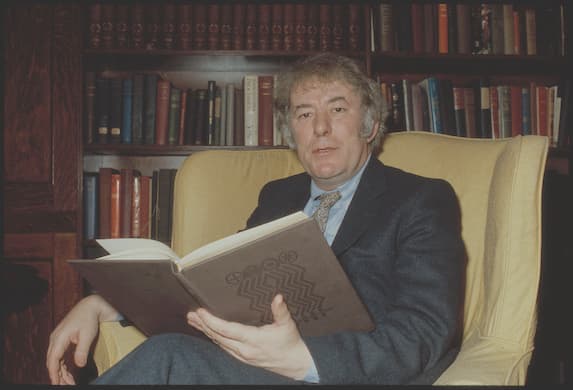Canvassing the Poet Seamus Heaney’s Many Sides
It is unusual to read about a male poet of Heaney’s generation who seems so even-tempered. Edward O’Shea’s own quietly confident prose is a good match for his subject.

‘Seamus Heaney’s American Odyssey’
By Edward O’Shea
Routledge, 226 pages
Nobel laureate Seamus Heaney (1939-2013) spent a good part of 40 years teaching in this country, yet he remained an Irishman, having been raised in Northern Ireland and living there as well as in the Southern Republic.
That Northern-Southern dualism served him well in his bi-coastal teaching positions at the University of California at Berkeley and Harvard. He came to the West Coast in 1970, expecting to confront hippies in the classroom. Instead he welcomed a generation of earnest students who won his affection and dedication.
By nearly all accounts in Edward O’Shea’s impeccable narrative, Heaney was a wonderful mentor to students, a gracious colleague, and grateful to a country that gave him stability and a respite from war-torn Northern Ireland. What Heaney was like as poet, husband, father, teacher, colleague, public figure, and a guest in this country are all canvassed in this compact biography.
“The Skunk,” one of Heaney’s finest poems — inspired, in part, by Robert Lowell’s “Skunk Hour” — shows how an Irish poet remained Irish while absorbing so much from a new land. Mr. O’Shea’s deft handling of Heaney’s poem, one of his letters, an interview with him, and one of his public lectures all concatenate to bring the reader of this biography to a wonderful sense of how the life and work of a writer converge.
The poet sees a skunk sauntering outside his rented home, with its shimmering black and white tail reminding him, as he told a Harvard audience, of a “Mae West figure.” “Skunk” begins in Ireland, in a bedroom scene with Heaney’s wife, but flashes back to the Berkeley skunk, melding, as Mr. O’Shea puts it, “into one arousing moment.”
Heaney, we learn, sometimes drove himself to exhaustion on the lecture circuit and slowed down when he realized he could not always give his best performance, forsaking larger fees as he reached out to audiences large and small in the West, Midwest, and East. Heaney’s patience and adaptability are impressive.
Heaney shows no signs of the mad drunken poet, a figure popularized in Dylan Thomas’s earlier adventures in America. That is not to say the poet did not enjoy and sometimes even crave a drink — as he did after a harrowing flight into foggy Iowa. Yet no matter how famous he becomes, he does not, in Mr. O’Shea’s account, ever pull rank.
Not that fame did not make a difference. After winning the Nobel Prize in 1995, Heaney felt obliged, since the world was watching, to become more involved with politics — attacking, for example, the policies of President George W. Bush.
In Ireland, Heaney had treaded very carefully during the “troubles,” preserving himself and his poetry from sectarian strife. Yet the pressures of becoming a world citizen, as it were, led to certain political poems that were not his best, Mr. O’Shea acknowledges.
Unlike Ted Hughes, a fellow poet who sampled the Northeast and drove cross-country, Heaney — whatever his criticisms — did not disparage American civilization. Especially in his later years, Heaney lectured on American poets, and Mr. O’Shea shows Heaney’s debts to them.
Mr. O’Shea — emeritus professor of English at the State University of New York, a director of five NEH seminars on the poetry of W. B. Yeats in Ireland, a Fulbright fellow at Trinity College, Dublin — is drenched in his subject even while he avoids academic jargon and emulates, I would say, Heaney’s spirit of outreach to the world.
It is unusual to read about a male poet of Heaney’s generation who seems so even-tempered and without the craziness that is often a staple of biographies of modern poets. Mr. O’Shea’s own quietly confident prose is a good match for his subject, who gained the world’s attention through a steady and inspiring dedication to his art.
Mr. O’Shea’s selection of photographs helps to tell his story, including those of Heaney’s rented apartment in Berkeley, the poet offstage preparing for an appearance at the 92nd Street Y, a lovely drawing of his rented home in Berkeley as he began to live in more ample surroundings, and Heaney at his desk in the attic study of his Dublin home.
Mr. Rollyson is the author of “Amy Lowell Anew: A Biography” and “Amy Lowell Among her Contemporaries.”

